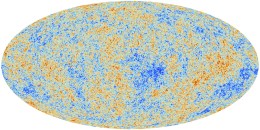
This image released on Thursday March 21, 2013 by the European Space Agency shows the most detailed map ever created of the cosmic microwave background acquired by ESA's Planck space telescope.
Astronomers love it when the cosmos throws them a curve ball. It’s all very well to peer deep into the universe and turn up just what you expect to find, but discovering something inexplicable is a whole lot more fun. That’s what happened in the 1970’s when observers found overwhelming evidence for the existence of mysterious (and still unexplained) dark matter, which invisibly holds the universe together; and again in late 1990’s when they learned that the expanding universe is speeding up, not slowing down, thanks in part to dark energy.
This being the case, you might think that the brand-new image of the early universe released by the European Planck satellite mission is something of a disappointment. It pretty much confirmed, with minor adjustments, what astronomers already know — that the cosmos is made mostly of dark matter and dark energy; that nearly 14 billion years have elapsed (13.8, to be exact) since the Big Bang; that during the very tiniest fraction of a second right at the beginning, the universe expanded at an incomprehensibly rapid rate—what physicists call the inflationary period. “It’s a confirmation of the most vanilla model of the universe,” says Rachel Bean, a Cornell astrophysicist.
It is up to a point, anyway. But Planck’s new image, which captures light dating from just a few hundred thousand years after the Big Bang also poses a mystery that could shake the foundations of cosmology. For decades, scientists have operated on the assumption that the universe should look the same, on average, in all directions—same number of galaxies, sprinkled about the sky in the same general pattern, no matter where you look. It’s a homogeneity which is in keeping with a birth blast that radiated out uniformly and at once.
(MORE: Scientists Find Universe is 80 Million years Older)
The ancient, leftover light from the Big Bang, however, seems lopsided, with a huge swath of sky at a slightly cooler temperature than the rest. It could simply be a fluke, like getting 50 heads in a row in a coin toss. Or it could mean that the age-old assumption about cosmic uniformity is wrong. The chance is maybe one in a few hundred that this asymmetry could happen randomly, says Bean. “So is it really significant or not? It’s tantalizing.”
As with the overall age and composition of the universe, this isn’t an entirely new finding: it was reported a decade ago by NASA’s Wilkinson Microwave Anisotropy Probe (WMAP) satellite. There was always a chance, though, that it was some sort of mistake—but not anymore. “Everything that WMAP saw, Planck sees,” says David Spergel, head of Princeton’s astrophysics department and a leader of the WMAP team.
If the cold spot does represent something more than just a random throw of the cosmic dice, it’s not clear what that something might be. “It could suggest that the universe is rotating,” says Spergel. That would account for an uneven temperature distribution, but, Spergel adds, “that’s inconsistent with other data.” It could also suggest that the universe is finite in size, and perhaps not a lot bigger than what we can actually see from Earth, but that appears to be inconsistent as well. At this point, says Spergel, “I don’t know of any compelling idea that would explain it.” The anomaly isn’t so glaring that it threatens our larger grasp of the universe, he admits, but “we may need some sort of new theoretical understanding.”
(MORE: Red Pill, Blue Pill: Is the Universe Just a Gigantic Computer Simulation?)
Things might get clearer with the development of future telescopes, including the ground-based Large Synoptic Survey Telescope (LSST), which could go into operation in 2021, and the space-based Euclid mission, scheduled for launch in 2020. They will do a better job of studying the far smaller hot and cold spots that make up Planck’s pointillist picture of the young universe and are the seeds that eventually grew into the huge clusters of galaxies we see today and the voids that lie between.
If LSST and Euclid see the same sort of pattern Planck sees, that will be further evidence that the cosmos really is lopsided—and that in turn could mean that theorists have a major curve ball to deal with.

